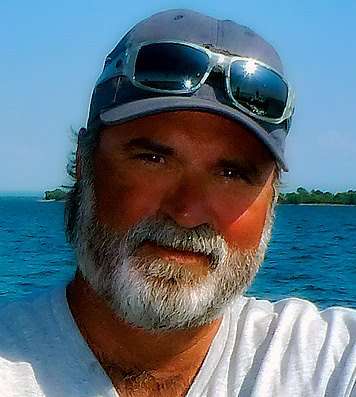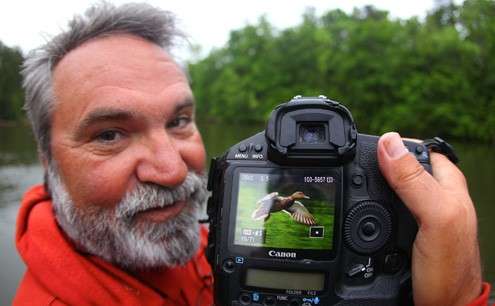
First I should mention that I’m thrilled about being asked to write a column for Bassmaster.com. I have hundreds of ideas to write about, but let’s just start from the beginning and get that out of the way.
One of the more frequent questions I get is, “How did you start your career with B.A.S.S.?” The year was 2006, and I wasn’t originally hired to shoot photos. I was hired to catch fish and track them.
Catching and tracking
Many of you may remember, the first two years of the Bassmaster Elite Series television show, Jerry McKinnis did a segment from each tournament lake that featured three to five fish that had been tracked before the practice period, during practice and finally during the tournament itself. I was the guy hired to go catch and track those fish.
When my lifelong friend, Steve Bowman with JM Associates (Jerry McKinnis’ company that produces the Bassmaster television show), first called and approached me with the idea, I thought surely there had to be a catch.
For the sake of absolute clarity I said, “Now let me get this right, ya’ll are gonna supply me with a new boat from Triton, I’m going to go to some of the best lakes in the country to catch fish AND you’re going to pay me and pay for all my expenses?”
Bowman said, “That’s right, that’s what we want you to do.”
After thinking on this proposition for about 30 seconds (maybe less), I said, “I’m in. When do I drive over to Triton and pick up the boat?”
We needed permits to do the tracking, insert the tracking devices and those sorts of things. While I was on the water catching the fish, I was accompanied by fisheries biologist Jeryl Jones. Jeryl was there to make sure we handled the fish correctly and the tracking devices were inserted correctly, with the least amount of harm to the fish.
The tracking device itself was roughly the size of a .45-caliber bullet. We would add a solution to the water in the livewell to “put the fish under,” so to speak. Then, we’d make a very small incision on the underside of the fish just in front of the vent, insert the device under the skin and add a couple of sutures to close the opening.
Find the fish
Here’s how the tracking apparatus worked: Each tracking device omitted its own unique “ping” and frequency. It was similar to sonar on a submarine you might remember from movies. One device might have two long pings then a short ping, the next would be three short pings, etc. The inserted devices were numbered, and I would record the number of the device along with the weight of the fish, sex, the depth and bait the fish was caught on, time, weather conditions and GPS coordinates.
The goal at each lake was to catch five fish over 3 pounds and have the tracking devices inserted into the fish before the pros arrived at the lake to begin their three days of practice. I was at each venue for usually 10 days and would check the location of the fish usually three times each day.
After locating my fish every morning, what would I do? Go fishing, of course! It was awesome. The first year I got to spend day after day fishing some of the best lakes in America, like Amistad, Sam Rayburn, and Guntersville. They were lakes I had always dreamed about fishing.
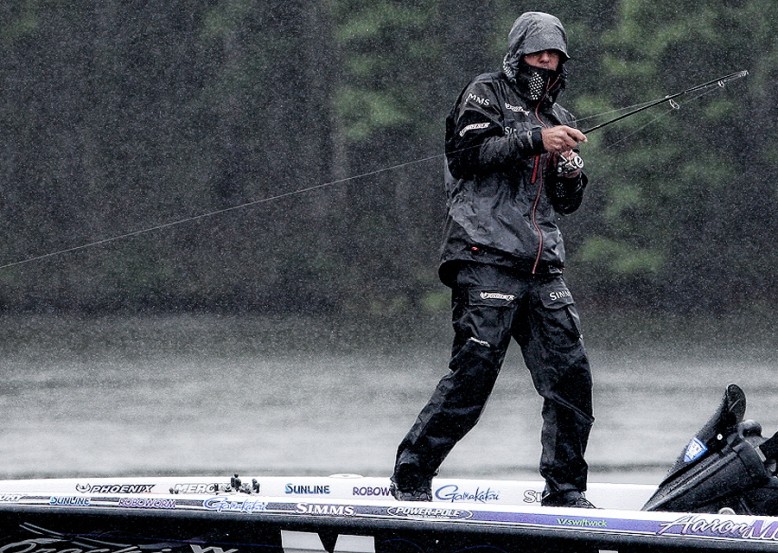
To find and track the fish, I would put a set of headphones on that was connected to a receiver, dial up the appropriate frequency for the device in the fish I was attempting to locate, place a cone in the water and listen for the “ping.” The reception range was advertised as about a quarter of a mile.
On the third day of each tournament, Jerry McKinnis would jump in the boat with me, and we’d shoot the television segment about what the fish had done during the tracking period. We would eventually do a show on his own private lake for his show, The Fishing Hole. For two lifelong bass fishermen, we were both fascinated with the project and what we could learn.
Three unique bass
I tracked nearly 100 fish during that first Elite Series season. It’s been a few years now, but three of those fish are stuck in my memory bank.
On the days we were to shoot the television segment, I would always go out before daylight and make sure I could find the fish. During the 2006 Lake Guntersville event, I tracked a 6-pounder I had caught along the same riprap wall where Randy Howell caught his fish on the final day of the 2014 Bassmaster Classic.
That fish moved a total of about three-quarters of a mile during the entire tracking period. He moved from the causeway, following the creek channel toward open water, and ended up on a hump at one point. But it was his final move during the tracking period that made for the most interesting story – where I found him on Day 3 of the tournament – the day we were shooting the television segment.
The dock we were launching the tournament from was directly across from the causeway. After the boats were gone from the morning launch, I pulled to the dock and tied off directly in from of the “T” of the dock to hook up with the television crew and Mr. Jerry.
One of the first things Jerry asked was, “Where’s the 6-pounder you’ve been tracking?” I pointed straight down between my feet. Overnight that bass had moved directly under the “T” of the dock the tournament was launching from.
But by far the most fascinating fish I tracked was on Santee Cooper in South Carolina.
I had caught, released and tracked a fish in a large bay in a backwater area of the lake. During the first day of the tournament I launched the boat and idled across the bay, fully expecting to find him on the bank he had spent several days on since he’d been caught.
I put the cone in the water but heard nothing. I idled up and down the bank over and over, but he just wasn’t there. I decided to move deeper into the bay. I was about to reach the other side of the bay, probably three-quarters of a mile from where I had found him the evening before, stuck the cone in the water and finally heard a very, very weak ping. But it told me all I needed to know. I idled farther and found him – completely on other side of the bay. He had moved across the entire bay overnight.
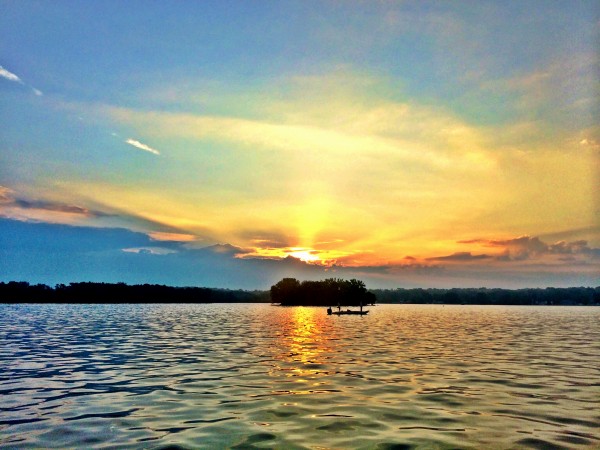
The next morning I’m out there to find the same fish, once again he was nowhere to be found. I moved back across the bay, looked and listened everywhere in the area…nothing. It was if he had totally vanished from the area. I’m looking at the GPS in the boat and decided to follow a channel that led to the main lake, stopping and listening to no avail. After spending three hours looking and listening, I began to think maybe the tracking device had failed.
I came to the mouth of a feeder creek, and I could see on GPS that it twisted and turned for nearly a mile to the east from where I was. I decided, why not? I idled into the creek, stopping to listen after every bend…nothing.
By looking on the GPS I could tell I was nearly to the back of the creek, one more bend to go. I rounded that final bend, stuck the cone in the water and the ping from that fish was loud and clear. He had moved to the back of the creek to spawn and stayed there the rest of the tournament.
After calculating his path on Google Earth, he had moved over a mile-and-a-half overnight!
At Lake Sam Rayburn, Randy Howell actually caught one of the fish I had been tracking. That fish was on a bed in about a foot of water, and I was actually worried a weekend angler would catch him. He was just too easy to see. I didn’t even need the tracking device to find him. I could idle by and see him on the bed 50-feet away.
But imagine the odds of one of our competitors bringing one of those fish to the scales during a tournament. I have no idea how many bass are in a lake the size of Sam Rayburn, but for one of our anglers to bring one of the five fish I was tracking to the weigh-in, that’s pretty darned remarkable.
Picking up the camera
Now let’s get back to what I do for B.A.S.S. today, which is take photos. How did I get into that? After the first day of the first Elite Series event ever – held on Lake Amistad – Steve Bowman asked if I would shoot the weigh-in.
“Sure, I’m here, might as well do something,” I replied.
And the rest, as they say, is history. I’ve shot every Elite Series tournament since.
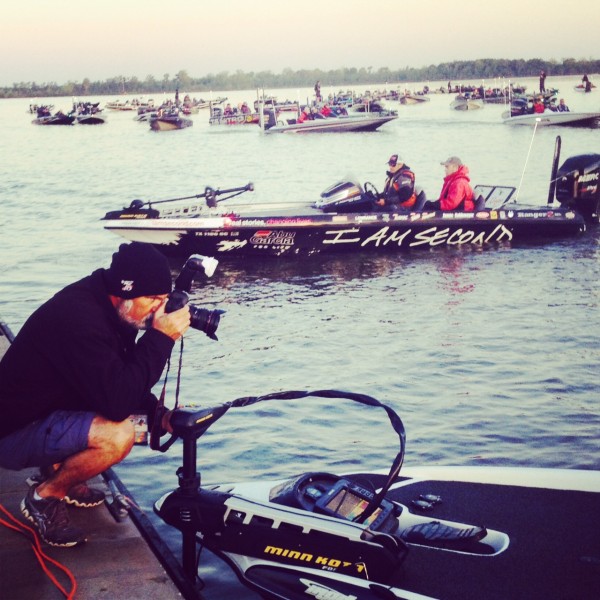
Moving forward we’ll talk about the stories behind some of the more memorable photos I’ve taken for B.A.S.S., etc. Some of them may have never been published. I’ve spent years now watching these guys fish and at last count taken nearly 500,000 photos since that first weigh-in at Lake Amistad. And that’s without mentioning the thousands of photos I’ve taken between tournaments, while traveling our country from coast to coast.
Along with the stories behind the photos, I’ve got a lot of ground I’d like to cover on a lot of different subjects…and more than a few Elite Series “campfire” stories to share with you. Whatever the subject matter, they’ll be a few things you can write in granite: I’ll probably piss somebody off and hopefully make somebody laugh. Sometimes you may enjoy what I write, and sometimes you’ll be just like me and wonder, “Why didn’t they just let that boy stick with taking pictures?”
If you’re so inclined, I invite you to follow me on Facebook. I put up a “Photo of the Day” and recently posted No. 1052. And when we’re at a tournament site, I usually post a story or two of what’s happening while we’re there and life on the road.
Happy new year to all of you!

